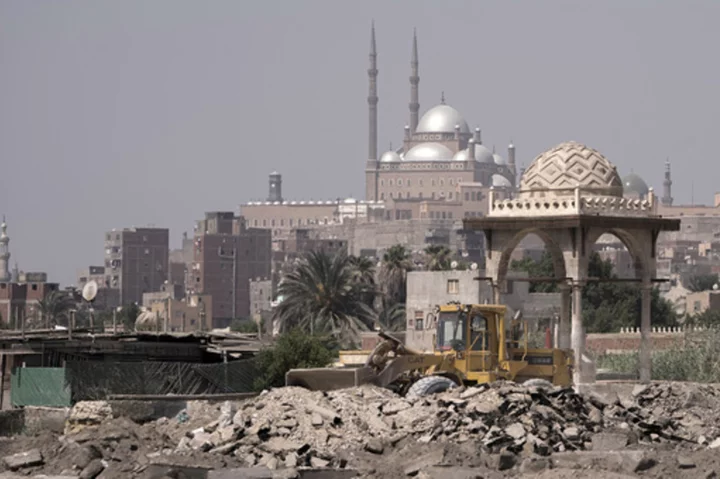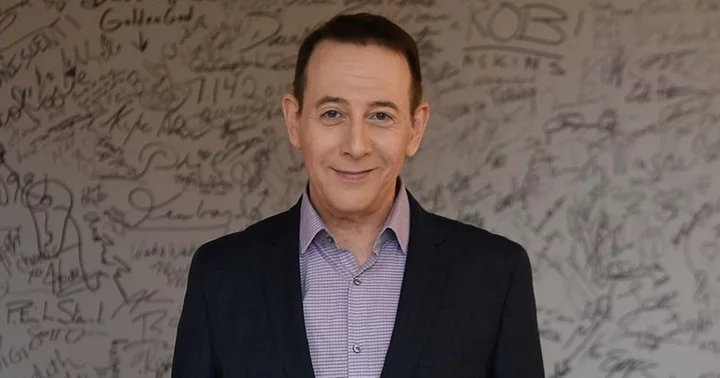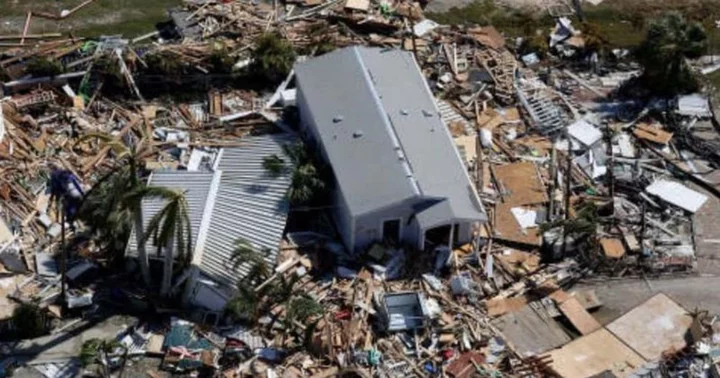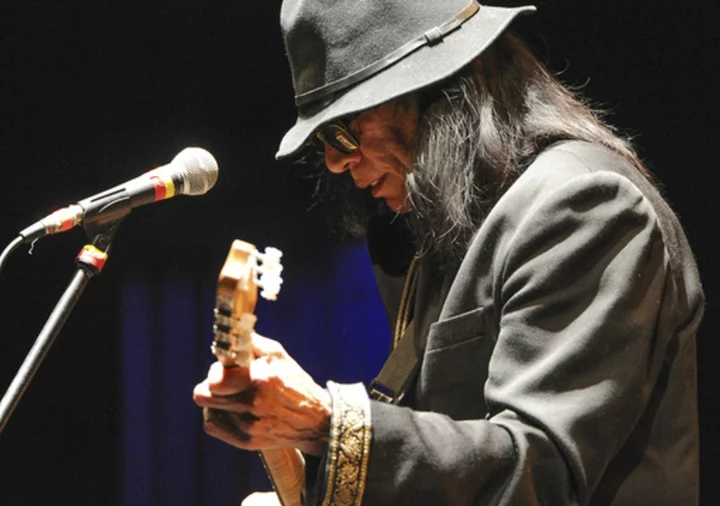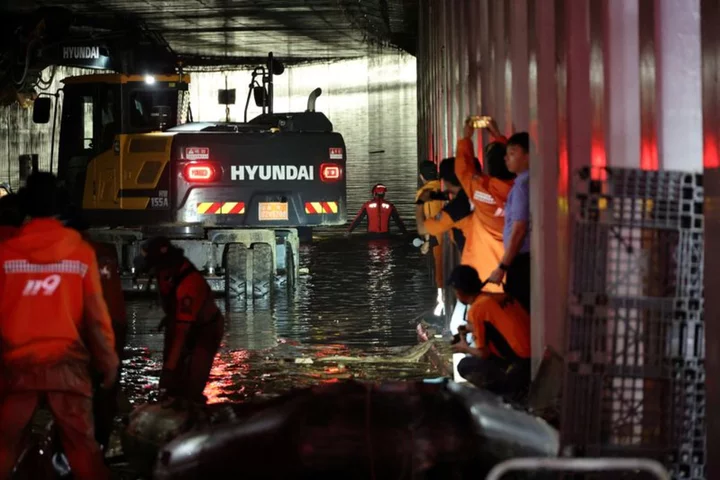CAIRO (AP) — The cane chairs and umbrella still stand in the courtyard of Hussein Omar’s family mausoleum, where his grandmother came every morning for 19 years after her daughter — his mother — died. Near her grave, she would sit and pray under the date palm and among the flowering plants, a few hours of peace in Cairo ’s historic City of the Dead.
Now the mausoleum, built in 1924 in a neo-Islamic style and housing the graves of a number of prominent Egyptians from a century ago, is threatened with demolition.
Authorities have already razed hundreds of tombs and mausoleums as they carry out plans to build a network of multilane highways through the City of the Dead, a vast cemetery that has been in use for more than a millennium. Stunned preservationists say the construction is destroying a unique part of Egypt’s heritage where major Islamic figures, prominent Egyptian politicians, artists and scholars and the loved ones of many Egyptians are buried.
“It’s always felt like a very sacred space. We always thought that whatever happens in the rest of Cairo, the City of the Dead would be safe,” said Omar, a historian who is writing a 500-year history of Cairo as told through the necropolis. "As we see now, that’s not the case.”
The work is part of a mega-building campaign by President Abdel Fattah el-Sissi that is reshaping the city of some 20 million people. His government has put up massive freeways and flyovers at a furious rate, torn down several older neighborhoods it considers slums and built housing projects. It has encouraged the growth of gated suburban compounds outside the city while building a giant new capital in the desert.
Though many support the roadwork to unclog congestion in the overcrowded city, the construction has also brought complaints of uprooting green spaces and trees.
But the cemetery destruction sparked an outcry that is unusual in an Egypt, where dissent has been squelched for years under el-Sissi.
Dozens of parties, activists, public figures and non-governmental organizations signed a petition in August condemning the destruction. Five members of a committee of experts formed by the government to study the cemeteries resigned in protest, saying authorities ignored its recommendations that demolitions be halted and alternatives to the routes be found.
The government’s project is destroying a “unique, architectural, historic fabric,” Ayman Wanas, an official with the government department that lists distinctive buildings, wrote in his resignation letter posted online. “It’s a waste of Egypt’s historic, valuable heritage which is irreplaceable.”
Apparently in response, authorities last week temporarily halted the demolition of tombs in the main part of the cemetery, a municipal official who oversees the eastern Cairo area where the cemeteries are located, told The Associated Press.
He said no explanation was given to the municipality, but he believes the government either wants to examine alternatives or wants to quiet criticism ahead of a meeting of the United Nations cultural agency, UNESCO, that started Sunday in Riyadh, Saudi Arabia. He spoke on condition of anonymity because he wasn't allowed to brief media.
Security agents told grave caretakers not to let anyone enter or photograph sites, several caretakers said.
The area is designated by UNESCO as a world heritage zone. But many preservationists sharply criticize the agency for remaining silent over the destruction. In a statement to the AP, UNESCO said it has expressed concerns to the Egyptian government and asked for more information on the work.
There was no official announcement of the temporary halt and no word that the highway plans had been changed.
The City of the Dead, covering nearly 2 square miles (5 square kilometers), has been a unique space in Cairo for centuries. Originally a desert plain outside the city, it first came into use soon after the Muslim conquest of Egypt in the 700s. Imam Shafii, one of the top scholars of early Islam, was buried there after his death in 819, and now the grey dome of his mausoleum-shrine towers over the district.
Over the centuries, it was filled with the tombs of Mamluk and Ottoman nobles and ordinary Egyptians. A rare large open space in Cairo, it has a stark beauty — quiet dirt paths run through a landscape of grave-markers, ancient domes and unexpected areas of greenery. Stately mausoleum compounds hold elaborately carved and decorated cenotaphs inside.
The area also abounds with life. Families come weekly to visit loved ones’ graves, spending the day with picnics and food. Generations of caretaker families live in the mausoleums. Kids fly kites on its empty roads in the evening. Tens of thousand of people live in residential neighborhoods within the cemetery, and on Fridays its main avenue is packed with an outdoor market.
The main demolitions so far have been in an area dotted with mausoleums of some of Egypt’s most notable families of the late 1800s and early 1900s. The government said it has given families who had to exhume and move their loved ones new burial plots, usually in the suburbs outside Cairo.
Omar’s extended family has five mausoleums in the cemetery, two of which are slated for destruction. His mother, who died in 2001, is buried in the Barakat family mausoleum. Among his forebearers there are Fathallah and Atef Barakat, two nationalist figures who participated in the 1919 Revolution against British colonial rule.
For Omar and others, the necropolis isn't just a historic site, but a center of personal memories and a place that joins life, death and peace.
Omar recalls visiting the mausoleum as a 6-year-old and asking his grandmother what the sound was that he was hearing. Raised in densely urbanized Cairo, he didn’t recognize the sound of birds singing.
“It is about the cohesiveness of the space, the peacefulness of the space. It has historically been a place of serenity,” he said. “What does it mean to have some lone surviving mausolea in the middle of a massive jumble of roads and traffic?”
In 2020, a large highway flyover was built across the southern end of the cemetery, razing hundreds of graves. The more extensive plans now reportedly include making way for two new highways, two large roundabouts, a giant cloverleaf and the widening of other roads.
Preservationists fear that will mean the City of the Dead's end: Carved up between highways, its remaining pieces would be vulnerable to further destruction.
The government has long argued the graves are not on a list of protected official historic Islamic and Christian monuments, a list that has hardly been updated in decades.
Two 700-year-old minarets on the list that are in the path of the roadwork are being dismantled and moved to another location. The planned highways weave within yards (meters) of several other registered monuments.
Prime Minister Moustafa Madbouly said in June that alternative burial sites are being provided for families moving their dead ahead of the construction. He said tomb markers of historic figures would be collected in a “Cemetery of the Immortals.”
Mostafa el-Sadek, a university professor who leads a volunteer initiative to document ancient graves and mausoleums, was frustrated by the government’s insistence on razing the tombs.
“The demolition must stop,” he said. “This area has layers and layers of history. Any problems, including the groundwater, could be resolved. It’s a matter of willingness.”

